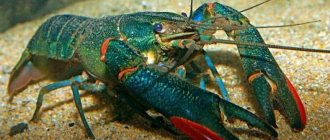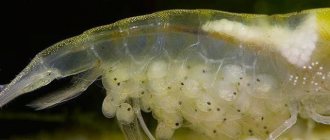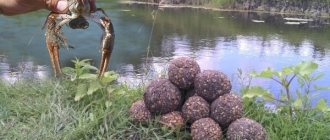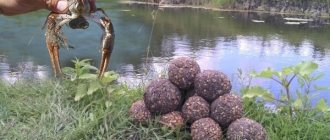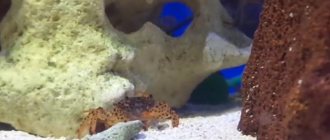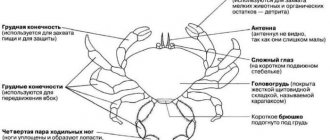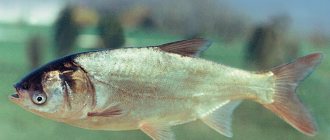Some people breed crayfish at home for aesthetics, while others do it as a business, because such an activity can bring considerable profit. However, in both cases, you should not forget about feeding them at home. Crayfish are omnivorous animals and are not particularly picky about food, so they can eat both plant and animal foods. In general, crayfish eat whatever they find most often, so keeping them is not difficult.
When feeding at home, it is advisable to provide crayfish with an environment as close as possible to their natural habitat, since they feed and look for food relying on their senses. It is advisable to pour clean river sand into the tank and throw a few stones there.
The ideal option for improving the food supply at home would be to place organic and mineral fertilizers; this is usually done before filling the tank with water. The proportions per 1 hectare of land are approximately as follows:
- Superphosphate – 1kg;
- Ammonium nitrate – 50 kg.
If you don’t have money for expensive fertilizers, then you can use any type of legumes. This type of fertilizer will enrich the water and soil with nitrogen. This method is not only cheap, but will also extend the time of use of the reservoir, as it is the most environmentally friendly.
In addition, for a good appetite for your pets at home, it is worth considering such parameters as temperature and acidity of the water. So, the pH mark should ideally vary from 7 to 8.5. But with heat it’s a little easier. The main aspect is that the water temperature should not be below 1 degree, and if it is close to 15, then the crayfish will feel great in it.
What do crayfish eat at home?
Crayfish are omnivores. Their diet contains both animal and plant foods. At home, stick to this menu when choosing food for crayfish.
Arthropods have a well-developed sense of smell. In nature, they quickly find dead fish by smell. At home, replace such prey with bloodworms, pieces of fish, meat, squid or shrimp.
Crayfish are given animal food no more than twice a week. There is a widespread belief that it increases the aggressiveness of arthropods.
Crayfish in their natural environment feed mostly on algae, but also come out onto land and feast on grass and leaves. To keep your pets in good shape, plant hornwort or elodea in the aquarium. Plants contain lime, which is necessary to maintain the strength of the shell or grow a new one after molting.
The following are also suitable as plant food:
- lettuce leaf;
- carrots, zucchini;
- spinach;
- nettle.
Regular feeding
In nature, the diet of crayfish consists of 90% plant foods. The remaining 10 are phytoplankton, invertebrates and small fish. Cancer eats dead fish and animal meat.
For convenience and to reduce the cost of time and money for maintenance, create natural living conditions:
- Apply organic and mineral fertilizers without exceeding the norm: nitrogen 0.5 mg/l, phosphorus 2 mg/l. Crayfish are susceptible to the composition of water and dirt will cause the animals to escape or even die. Apply fertilizers before filling the reservoir. Industrialists have a recommended proportion of 1 kg of superphosphate and 50 kg of ammonium nitrate per 1 ha.
- Fertilizers can be replaced with legumes. Their use is environmentally friendly and saturates the water with nitrogen.
- The acidity in the reservoir should not exceed 7–8.5 pH.
- To provide the elements necessary for the growth of a new shell, plant plants rich in lime.
- Introduce daphnia, cyclops, snails, tadpoles and small fish into the pond. By catching them, crayfish will be able to partially provide themselves with food. Phyto and zooplankton will serve as food for both the crayfish themselves and their prey.
How to feed crayfish when catching them?
Bait for catching crayfish is selected based on the season of the year. Vegetable complementary foods are effective in spring and summer. In autumn and early winter, animal food is used to feed arthropods. For this use:
- meat trimmings;
- fish;
- entrails of fish and poultry;
- shellfish;
- worms;
- snails;
- frogs;
- meat.
The fish is served fresh or slightly spoiled. To enhance the smell, it is dried a little in the sun. Cancers like roach, crucian carp and bream. For meat products, it is advisable to use poultry or meat carcass. It is also served stale. Clams, snails and frogs are caught in the same body of water where they are going to catch crayfish. Worms are used extremely rarely in the absence of other options: they are placed in a piece of thin gauze, preventing them from spreading.
Of the vegetable baits, it is most effective to use corn, dill, peas, black bread, macadamia, and garlic. Peas and corn are boiled, steamed or purchased canned. Crustaceans are attracted to the garlic aroma, which is why it is recommended to add it to other products.
When choosing bait, take into account the time of year:
| Season | What to feed? |
| Summer | They are fed with a piece of liver, meat, and chicken giblets. To enhance the smell, fish oil is added. |
| Spring | They use vegetable bait or fish, which are first cut along the ridge, turned inside out and left in the sun to spoil. |
| Winter and autumn | It is recommended to use rancid meat or peas. |
The habitat is also very important. For hunting in reservoirs with muddy bottoms, it is advisable to use bait made from spoiled fish. It is a common food for crayfish that live in such conditions. Arthropods will crawl into the “trap” without suspecting anything. If there is a lot of vegetation at the bottom, using peas or corn is more effective.
For fishing in underwater caves or under the shore, bait with a strong smell of garlic or spoiled meat is used. In shallow water, experts advise using worms, shellfish, and corn for bait.
Types of feed
Crayfish are omnivorous, with the exception of products with synthetic and chemical additives. Feed can be either industrial or self-prepared.
Self-cooking
When creating your own diet, remember to balance animal and plant foods. Homemade food for crayfish includes:
- pieces of raw meat, chicken, fish;
- earthworms, maggots, bloodworms;
- a variety of vegetables;
- nettle;
- bread;
- seaweed.
Do not give crayfish fatty foods, which will pollute the water.
Industrial manufacturing
Release form: flakes, granules of different sizes or sticks. Regardless of appearance, the food chosen should be:
- balanced;
- do not pollute water;
- contain elements that facilitate molting.
Some types of feed are formulated specifically for different stages of cancer's life. There are varieties of complementary foods to stimulate reproduction, enhance the color of the shell, and strengthen the immunity of the fry.
Compatibility of crayfish with aquarium fish
The issue of compatibility between crayfish and aquarium fish gives rise to many disputes on aquarium forums. It is better to keep crayfish separately from fish and here's why.
The proximity of dwarf crayfish and small aquarium fish is possible, however, it is associated with some problems. During the molting period, crayfish are extremely defenseless during the first day, until the shell hardens. Even small fish, like microrasbor, can seriously injure or even kill crayfish. The rest of the time, on the contrary, cancer, which is a predator by nature, can attack small fish and injure them.
The proximity of crayfish to large fish is excluded. Cancer will starve, afraid to get out of the shelter in search of food, and everything will end in tears.
Rules and features of feeding
- Crayfish are thrifty creatures and know how to hide food. Excess food will cause the water to dry out and the pets will die.
- Control your diet so that you have enough food, but not excess.
- During molting, more food is required, this is due to the energy costs of restoring the shell.
- The breeding season also requires an increase in portions.
- The diet of juveniles differs in composition and volume from the diet of adults.
- Males can feed once every 2 days, and females once every 3 days.
- Leave the shell in the aquarium after molting. It is part of the diet of wild arthropods. By eating the shell, they restore the normal level of calcium in the body.
- Crayfish are nocturnal animals. Feed them in the evening.
- Make sure there is enough food, otherwise the crayfish may start eating each other.
- But also a lack of food will lead to attempts by arthropods to escape.
When do the most powerful anti-cancer products fail?
Do not underestimate the insidiousness of carcinogens - potentially dangerous agents that cause irreversible changes in the genetic apparatus of cells, provoking their uncontrolled division and the appearance of malignant neoplasms. After all, they surround us at every step, and the harm they cause tends to accumulate.
If the human body is daily exposed to the negative influence of industrial waste, car exhaust gases, tobacco smoke, ultraviolet rays and other factors, then it is quite difficult to neutralize their effects and the effectiveness of any anti-cancer diet will not be enough. In this case, a kind of “race to get ahead” will begin, in which healthy food products are unlikely to win.
Do not forget that products that destroy cancer cells can also be potentially dangerous. After all, along with useful substances, they may also contain carcinogens - cadmium, nitrates, nitrites, pesticides, food additives and other harmful components. For example, a person eats tomatoes with pleasure, counting on their anti-cancer effect, but in fact they are grown using dangerous agricultural chemicals and are harmful to the body.
Eating foods that cause cancer is another problem that each of us faces. After all, eating only avocados, eggplants, grapes, pomegranate juice, walnuts and other anti-cancer foods is expensive and unreasonable. The average Russian cannot exclude from his diet sugar, animal fats, red meat, confectionery and other products that can provoke carcinogenesis.
So, following an anti-cancer diet is pointless? Yes and no! On the one hand, eating anti-cancer foods does not provide a 100% guarantee of not getting sick throughout your life, and on the other hand, following a diet reduces the risk of developing cancer pathologies. Moreover, it reduces significantly – by 40% in men and by 60% in women. The main thing is a reasonable approach to organizing your diet and lifestyle.
Norm in the diet
- The female eats more than the male, but also takes longer to digest food.
- There is no clear standard for the amount of feed. Fresh food is added to the feeder only when it is empty.
- The remaining food is removed after two days, otherwise the decomposition process will begin, polluting the water in the aquarium.
- 2–3% of the animal’s weight is the recommended amount of food. Pets will be full and there will be no surplus left.
- It is better to slightly underfeed the crayfish than to allow them to die due to spoiled water.
Feeding the young
The growing body of young crayfish requires a larger volume of varied food.
Before reaching a length of 2 cm, they require detritus - a product of the breakdown of organic matter. In nature, at the bottom of a reservoir, it is quite enough for young individuals. Due to constant filtration, there is not enough detritus in the aquarium.
Dry leaves of oak, alder or beech are used as feed. Not only young crayfish eat them, but also adults. Add leaves as you eat them. Do not use fresh leaves. They are capable of releasing a dangerous toxin into the water. Two-centimeter crustaceans begin to eat various insect larvae. From three centimeters of height, shellfish are included in the diet. Having reached 4 cm, the crustaceans begin to eat small fish.
You can feed young fish at home using food intended for fish fry. Aquarists advise adding small daphnia to the diet. Before being introduced into the aquarium, daphnia is scalded with boiling water to reduce mobility.
Nutrition for prostate tumors
To alleviate the condition of prostate cancer (especially after surgery), it is important to adhere to the menu below.
Monday
Breakfast: 250 milliliters of grapefruit-orange juice (freshly squeezed).
Lunch: 200 grams of fruit and millet porridge, 50 grams of oatmeal cookies.
Lunch: 150 grams of lentil puree soup, 100 grams of carrot-garlic salad, 70 grams of fish meatballs, 20 milliliters of flaxseed oil.
Afternoon snack: 100 grams of baked beans in tomato.
Dinner: 100 grams of any berries, 50 grams of any cheese.
Tuesday
Breakfast: 150 milliliters of carrot-beet juice (freshly squeezed).
Lunch: 100 grams of cottage cheese, 20 grams of natural honey, 15 grams of sesame seeds.
Lunch: 150 grams of barley or buckwheat porridge, 70 grams of boiled chicken, 100 grams of cabbage salad.
Afternoon snack: 150 grams of baked eggplants with tomatoes.
Dinner: 100 grams of yogurt (homemade), 50 grams of dried fruits (dates, dried apricots, raisins).
Wednesday
Breakfast: 100 grams of seasonal fruits or berries.
Lunch: 70 grams of oatmeal cookies, 20 milliliters of honey, 20 grams of assorted nuts (walnuts, hazelnuts, almonds).
Lunch: 150 grams of tomato soup, 100 grams of chopped vegetables, 70 grams of jacket potatoes, 15 milliliters of olive oil.
Afternoon snack: 100 grams of vinaigrette.
Dinner: 100 grams of carrot-beet juice.
Thursday
Breakfast: 150 milliliters of apple and pumpkin juice.
Lunch: 100 grams of avocado salad, 50 grams of fresh carrots.
Lunch: 150 grams of pureed rice soup, 70 grams of meatballs, 100 grams of tomato.
Afternoon snack: 150 grams of prune and beet salad, 15 milligrams of flaxseed oil.
Dinner: 100 grams of assorted nuts, 100 milliliters of cranberry juice.
Friday
Breakfast: 100 grams of any berry juice (freshly squeezed), 50 grams of dried apricots.
Lunch: 150 grams of cottage cheese, 50 grams of seasonal fruit.
Lunch: 150 grams of carrot and cabbage puree, 100 grams of chopped vegetables, 70 grams of fish cutlets, 15 milliliters of flaxseed oil.
Afternoon snack: 200 milliliters of green tea, 70 grams of oatmeal cookies.
Dinner: 100 grams of kefir.
Saturday
Breakfast: 150 milliliters of beetroot-orange juice, 100 grams of nuts.
Lunch: 150 grams of cottage cheese casserole. 150 milliliters of green tea.
Lunch: 150 grams of pea soup, 70 grams of avocado and lemon salad, 10 milliliters of flaxseed oil.
Afternoon snack: 100 grams of yogurt, 20 grams of flower honey.
Dinner: 200 milliliters of herbal decoction.
Sunday
Breakfast: 150 milliliters of apple and grapefruit juice.
Lunch: 100 grams of seasonal fruits or berries, 20 grams of almonds.
Lunch: 150 grams of stuffed peppers, 100 grams of leafy green salad, 15 milliliters of flaxseed oil.
Afternoon snack: 200 milliliters of burdock decoction, 50 grams of biscuits.
Dinner: 150 grams of cottage cheese casserole.
In addition, to increase natural antitumor protection, the menu of a cancer patient is enriched with beetroot juice (on an ongoing basis).
Adviсe
- In summer, the amount of food needed increases.
- In winter, when kept outdoors, there is no need to feed crayfish until spring.
- Their growth and reproduction rate depend on what they feed crayfish.
- Crayfish do not like turbidity in a pond.
- A properly prepared living area will reduce feed costs.
- For the growth of juveniles and reproduction, a comfortable temperature of about 15 degrees.
- Crayfish are inhabitants of clean bodies of water; their behavior makes it immediately obvious if something is wrong with the water.
